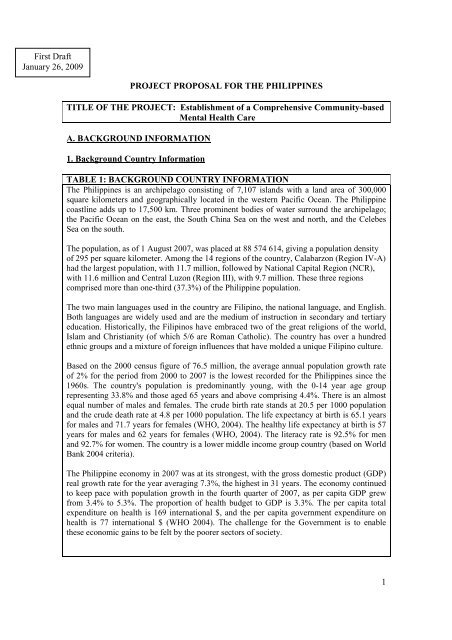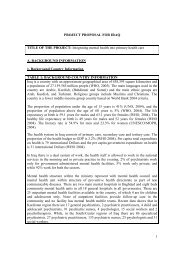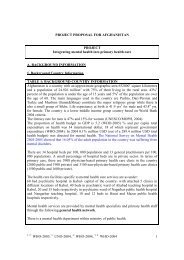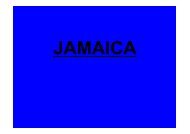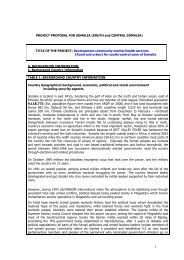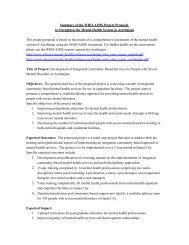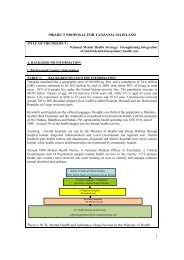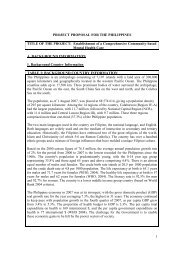PROJECT PROPOSAL PHILIPPINES - Cittadinanza
PROJECT PROPOSAL PHILIPPINES - Cittadinanza
PROJECT PROPOSAL PHILIPPINES - Cittadinanza
You also want an ePaper? Increase the reach of your titles
YUMPU automatically turns print PDFs into web optimized ePapers that Google loves.
First DraftJanuary 26, 2009<strong>PROJECT</strong> <strong>PROPOSAL</strong> FOR THE <strong>PHILIPPINES</strong>TITLE OF THE <strong>PROJECT</strong>: Establishment of a Comprehensive Community-basedMental Health CareA. BACKGROUND INFORMATION1. Background Country InformationTABLE 1: BACKGROUND COUNTRY INFORMATIONThe Philippines is an archipelago consisting of 7,107 islands with a land area of 300,000square kilometers and geographically located in the western Pacific Ocean. The Philippinecoastline adds up to 17,500 km. Three prominent bodies of water surround the archipelago;the Pacific Ocean on the east, the South China Sea on the west and north, and the CelebesSea on the south.The population, as of 1 August 2007, was placed at 88 574 614, giving a population densityof 295 per square kilometer. Among the 14 regions of the country, Calabarzon (Region IV-A)had the largest population, with 11.7 million, followed by National Capital Region (NCR),with 11.6 million and Central Luzon (Region III), with 9.7 million. These three regionscomprised more than one-third (37.3%) of the Philippine population.The two main languages used in the country are Filipino, the national language, and English.Both languages are widely used and are the medium of instruction in secondary and tertiaryeducation. Historically, the Filipinos have embraced two of the great religions of the world,Islam and Christianity (of which 5/6 are Roman Catholic). The country has over a hundredethnic groups and a mixture of foreign influences that have molded a unique Filipino culture.Based on the 2000 census figure of 76.5 million, the average annual population growth rateof 2% for the period from 2000 to 2007 is the lowest recorded for the Philippines since the1960s. The country's population is predominantly young, with the 0-14 year age grouprepresenting 33.8% and those aged 65 years and above comprising 4.4%. There is an almostequal number of males and females. The crude birth rate stands at 20.5 per 1000 populationand the crude death rate at 4.8 per 1000 population. The life expectancy at birth is 65.1 yearsfor males and 71.7 years for females (WHO, 2004). The healthy life expectancy at birth is 57years for males and 62 years for females (WHO, 2004). The literacy rate is 92.5% for menand 92.7% for women. The country is a lower middle income group country (based on WorldBank 2004 criteria).The Philippine economy in 2007 was at its strongest, with the gross domestic product (GDP)real growth rate for the year averaging 7.3%, the highest in 31 years. The economy continuedto keep pace with population growth in the fourth quarter of 2007, as per capita GDP grewfrom 3.4% to 5.3%. The proportion of health budget to GDP is 3.3%. The per capita totalexpenditure on health is 169 international $, and the per capita government expenditure onhealth is 77 international $ (WHO 2004). The challenge for the Government is to enablethese economic gains to be felt by the poorer sectors of society.1
In the health domain, the government allocated five percent (about 484million+ pesos) of thebudget of DOH towards mental health. Of all the expenditures on mental health, 95% arespent on the operation, maintenance and salary of personnel of mental health facilities. ThePhilippine Health Insurance Corporation recently covered mental illness but limited only topatients with severe mental disorders confined for short duration. Likewise, mental healthand psychosocial services are included in the outpatient package of Philhealth for theOverseas Filipino Workers.There are varied types of mental health facilities in the Philippines and some need to bestrengthened and developed. The Department of Health maintain and operate ten psychiatricin-patient facilities, located in general hospitals throughout the country. Of the above 10regional mental health facilities, four were previous regional mental hospitals that account for1,400 of the 2,250 hospital beds, and were therefore former specialist mental health servicefacilities. At present, there are no district psychiatric in-patient facilities. The onlyDepartment of Health (DOH) psychiatric facility in the National Capital Region is theNational Centre for Mental Health with capacity of 4,200 beds. Other government hospitalsin Metro Manila, with mental health unit include the Philippine General Hospital, VeteransMemorial Medical Centre and Armed Forces of the Philippines Medical Centre. The onlylocal government hospital with mental health facility is the Cavite Centre for Mental Healthin Trece Martirez, Cavite. All of these non-DOH facilities comprise a total of 575 beds. Theyprovide acute to long-term in-patient care, crisis stabilization care, and specialized wards forthe treatment of specific conditions, specialist units for children and adolescents and theelderly. Like any other mental hospital elsewhere, it provides institutionalized care to manyof its patients.There are informal links between the mental health sector and other sectors, and many of thecritical links are weak and need to be developed (i.e., links with the welfare, housing,judicial, work provision, education sectors). The mental health information system does notcover all relevant information in all facilities. There are few community mental healthservices in the country. They are mostly provided by NGOs, religious organization and somepharmaceutical companies through advocacy services. Family members are a significantinfluence to help-seeking behaviour and mental health service utilization.Against this backdrop, one can surmise that mental health system in the Philippines remainto be institution based despite the passage of the National Mental Policy. Furthermore,access to mental health facilities is uneven across the country, favoring those living in or nearthe major cities. Although, some aspects of life in the hospitals have improved, the number ofpatients has grown steadily. Unfortunately, low priority on mental health is a significantbarrier to develop the treatment of patients in the community .2. Background to the current project proposalTABLE 2: BACKGROUND TO THE CURRENT <strong>PROJECT</strong> <strong>PROPOSAL</strong>The Department of Health institutionalizes the National Mental Health Program through theNational Mental Health Policy signed in 2001 and its implementing guidelinesAdministrative Order 2007- 009, otherwise known as the “Operational framework forSustainable Establishment of a Mental Health Program”. The said AOs specified strategies2
for national reforms ‘from an institutionally based mental health system to one that isconsumer focused with an emphasis on supporting the individual in their community’.Thus, in order to implement the set goal, it prescribed the creation of functional managementstructures that groups mental health stakeholders into different committees, aimed atmainstreaming the programs & services to the community through establishment of thenational, regional & local mental health team.The said AO envisions that if the mental health team in the community is to be functional,access to mental health services & promotional activities must be available in the community.The present response of the local government, non government organizations, private andacademic institutions involve in mental health, indicate that there is need to intensify publicawareness of mental health as an integral component of the primary health care.In relation to these, the program initiates pilot activities to selected communities in BicolRegion to accelerate the process of reforms. In partnership with CBM, the national mentalhealth program decided to conduct consultative meetings with local stakeholders as initialsteps in establishing local mental health team.Equipped with a better understanding of Bicol region’s mental health needs and resources,the DOH and CBM Community Mental Health Program have jointly developed a five-yearproject that will strive to help communities in Bicol region better meet the mental healthneeds of its people. Members of Bicol regional mental health team have signed pledge ofcommitment; crafted their vision, mission and goals, as well as plans of activities and now inthe process of developing training manual for local health workers. The Bicol regional teamis gradually achieving the objectives they have set a year ago.The project is the initial step to build a model to implement the national mental health plan. Itindicates very positive response from the community and provides an enlightening results.Henceforth, it is now proposed that a similar projects be conducted on a much larger scale sothat policy makers would have a more solid foundation to develop a comprehensive programon mental health, as envisioned by the National Mental Health Policy, which is proactive andrelevant to current situation of the country.3. Analysis of the strengths and weaknesses of the mental health system.Table 3: WHICH ARE THE THREE MAIN STRENGTHS OF THE COUNTRYMENTAL HEALTH SYSTEM?1.The National Mental Health Policy and its implementing guidelines which address themain issues of mental health in the country.2. Academic institutions and training centers that have developed good programs to educateand develop mental health human resources, specifically psychiatrists, psychologists, socialworkers, nurses and allied mental health professionals.3. A local government instituted rural health units throughout the country, managed by eitherphysicians and/or public health nurses, midwives, sanitary inspectors and village healthvolunteers.3
Table 4: WHICH ARE THE THREE MAIN WEAKNESSES OF THE COUNTRYMENTAL HEALTH SYSTEM?1. The majority of mental health facilities are still located in the National Capital Region.Hence, access to mental health facilities is uneven across the country, favoring those livingnear the main cities.2. Majority of the community-based physicians trained on identification and managementmental health problems are no longer in their place of duty, and the current primary healthcare staff seem to have inadequate training in mental health3. The distribution of human resources for mental health is quite uneven favoring that of themain cities.B. DESCRIPTION OF THE <strong>PROJECT</strong>Table 5: BRIEF DESCRIPTION OF THE <strong>PROJECT</strong>The project is being proposed to establish a comprehensive and sustainable community basedmental health care. Community based care means that the large majority of patients requiringmental health care should have the opportunity to be treated at the community level. It hastwo components namely the community mental health and the psychosocial rehabilitationprograms for chronically mentally ill. Community mental health aims to promote mentalhealth and prevent mental disorders, while the psychosocial rehabilitation program aspire toincrease the social integration of people with chronic mental disorders.It also aims to create partnership with non government organizations that advocate the rightsof mentally ill and empowerment of their families. The services may include a wide array ofstrategies and settings at different levels of care, provided by mental health professionals andPara-professionals, working in multidisciplinary teams. It will also promote efficient referralsystems to appropriate health facilities and agencies.The initial activity is to establish a functional local mental health team composed of localstakeholders from the government and private sectors, that would ensure effectiveimplementation of national mental health plan.The project is proposed to be implemented in the North Cotabato Province-Region XII ofMindanao. The said province was chosen because of its enormous need for mental healthservices, considering that they are exposed to a yearlong natural disasters and vulnerability toarmed conflicts. Furthermore, availability of service providers and mental health specialistsare very scarce in the area. The program is envisioned to be extended to all the provinces ofRegion XII after the project is evaluated and revised.Table 6: DESCRIPTION OF THE WEAKNESSES IN THE MENTAL HEALTHSYSTEM THAT THE <strong>PROJECT</strong> TACKLES1. The current primary health care staff have inadequate training in mental health andinteraction with mental health facilities is uncommon.2. More than fifty percent of psychiatrists are based near the main cities and most of themwork in for-profit mental health facilities and private practice .3. Family associations are present in the country but are not involved in implementing4
Steps towards implementation of the project- Please describe the specific activities that are planned for the project. Divide the project into steps and for each step of the project providedetails on:o WHAT SPECIFIC OBJECTIVES WOULD YOU LIKE TO ACHIEVE THROUGH THIS <strong>PROJECT</strong>? (e.g. what specificgoals do you want to achieve). Please include plans for a mid-term and final evaluation.o ACTIONS (what is going to be done?)o ACTORS (who will be responsible for implementation of the activity?)o TIME (how much time will it take to accomplish each step?)o RESULTS (list the specific results expected at the end of each step. Make sure the results are written in measurable terms. Forexample, 100 nurses will be trained on mental health; a training manual on the identification of mental disorders will be developed,etc).o INDICATORS (include the specific indicators (WHO-AIMS and others) that will be used to measure the success of each of thespecific results expected. For example, an indicator on the number of nurses graduated from the training programme will be used;a post training test to assess the knowledge gained through the training programme will be developed).Table 8Step 1SPECIFICOBJECTIVETo establish anintegrated andcommitted NorthCotabato ProvincialMental HealthTeam that will beresponsible in theplanning andimplementation of acommunity basedmental health careprogram, as well asassist in themonitoring andACTIONS ACTORS TIME RESULTS INDICATORSPhase1 NGAsConsultativeworkshop to assessthe presentresources andservices available inthe province.Department ofHealth Focal Personon MH; RegionalMH coordinators;Regional Hospital;Cotabato ProvincialHealth Officer;Municipal HealthOfficers and staff ofthe Cotabato; othergovernmentagencies; NGOs andPeoples’3 rd quarter of2009Identify the ff:a. Perceive needs& issues ofCotabato Provincein relation tomental healthb. Availablemental healthservicesc. Treatment gapsd. Areas ofcollaboration inthe communityNumbers of attendees tothe workshop fromnational, regional andprovincial agencies andorganization.6
evaluation.Phase 2Orientation andorganizationalworkshop ofprovincial healthteamorganization;Academe andreligious leaders.ProgramCoordinators fromNational, provincialand localgovernmentagencies;Representativesfrom Academe,Non-GovernmentOrganizationsPeoplesOrganizations andreligious leaders4 th Quarter of2009a. Roles andresponsibilities ofthe differentstakeholders withregards to mentalhealth andpsychosocialissues areclarified;b. Provincialmental healthteam isestablished.a.Provincial Plan ofActionb. Stakeholders’ Pledgeof Commitment to theMH program.Phase 3Advocacy for anintensified healthpromotion activitiesfor communitybased MH programat the regional andprovincial level.Governmentagencies, nongovernmentorganizations,academe, the privatesector and people’organization4 th Quarter of2009 – 1 stquarter of2010a. It will creategreater publicawareness andunderstandingof mentalhealth andtherebyencourageactive supportand networkingNumbers of committedstakeholders fromgovernment and privatesectors, as well asfamily & consumerorganizations.7
Step 4Step 5with mentaldisorders living inthe community.Mid-term evaluationof project in theidentified provinceon establishment ofcommunity basedmental health careEvaluation ofprojectwith chronic mentalillness and otherpsychologicalproblemsc. Livelihoodactivities for peoplewith chronic mentalillnessa. Create team totake over theresponsibility fordesigning andimplementing anevaluation ofprogress usingappropriateindicators.b. Hold meetings/workshop/projectvisitation to discussresults and suggestmodification forfurtherimplementationa. Evaluate progressof the project usingidentified andappropriateindicators.b. Hold workshop todiscuss resultssocieties,Communityvolunteers, projectstaff (users andfamilies)Department ofHealth Authority(Regional directorand DOHrepresentatives);Provincial healthofficer;Director of NationalCentre for MentalHealth, WHODepartment ofHealth (Regionaldirector and DOHrepresentatives);Provincial healthofficer;Director ofNational Center forMental Health,WHO representative4 th quarter of2010heir families.Mid-termevaluationcompleted andlessons learntsummarized forimplementation inother provinces2011 Evaluationcompleted andworkshop heldseminars and receivedassistance for livelihoodprojects.a. Mid-term evaluationteam establishedb. Assessment toolswith objective indicatorsadministeredc. Number of meetingand workshop.Evaluation report9
Table 9: DIFFICULTIES AND SOLUTIONSEXPECTED DIFFICULTIESPOSSIBLE SOLUTIONS TOWARDSTHE EXPECTED DIFFICULTIESResistance from the Local Government units, 1. Orient local chief executives on the meritswho are autonomous from the National of the program and promote inter-agencygovernment, to allocate fund or share in the linkages among stakeholders on mentalfunding of the community mental health health and psychosocial issues.program2. Mobilize resources from other fundingagencies.3. Advocate that health, not only mentalhealth program, is a shared responsibilities.Limited coordination between and amonggovernment and non-governmental agenciesproviding prevention, treatment,rehabilitation, disability support and socialservicesNon-compliance to the principles of humanrights of people with mental disorders anddisability, such that forced confinement maystill be commonly practiced.Institutionalize a functional managementstructure that would bridge the gap andcoordinate among agencies involve in theimplementation, monitoring and evaluationof community mental health program.Advocate programs to protect the right ofindividual with chronic illness such as rightto confidentiality, right for education andright for speech and right of clients foremployment,C. IMPACT OF THE <strong>PROJECT</strong>Table 10:WHAT WILL BE THE IMPACT OF THE <strong>PROJECT</strong> (e.g. in terms ofaccessibility of mental health facilities, availability of medicines or interventions,improved follow up, more respect for human rights, implementation of new interventions,etc)1. Increase access to treatment and care in the primary health care network, supported bydedicated mental health providers and stakeholders.2. Decongestion of patients in mental hospitals3. Change in health seeking behavior of families. They will no longer feel stigmatized whentheir relatives are referred for consultations to general hospitals and medical centers withAcute Psychiatric Unit nearest to their home4. Increase the role of consumers and family caregivers as participants in policy-making andservice management10
BUDGETARY REQUIREMENTS:Step1- Phase I - Consultative Assessment WorkshopActivity – 8 hrs. workshop35 - participants- Food & Accommodations = P 35,000.00- Transportation = 100,000.00- Workshop Supplies & Materials = 20,000.00- Communication = 10,000.00- Documentation & Reproduction Cost = 5,000.00- Honorarium =- Miscellaneous = 15,000.00___________Php 185,000.00US $ 3,700.00Phase 2 - Orientation and Organizational WorkshopActivity – 8 hrs / 2days Workshop30 – Participants- Foods& Accommodations = P30,000.00-Transportation = 70,000.00- Venue = 4,000.00- Materials = 3,000.00- Communication = 3,000,00Php 110,000.00US $ 2,200.00Phase 3 – Advocacy CampaignActivity – 8 hrs. workshop/3days20 - participantsFood& Accommodations = 46,020.00Administrative Cost = 7,400.00Supplies & Materials = 10, 580.00Hired vehicles = 10,000.00Php 74,000.00US $ 1,480.0011
Step 2 - Training of Community Based Health Workers on Mental HealthActivity 2 – 5 day training workshop35 participants- Food & Accommodations Php = 262,500- Transportation = 70,500- Workshop Supplies & Materials = 20,000- Miscellaneous = 40,000- Special Metings w/ LGU’s, NGO’s = 10,000- Honorarium (Resource Persons/Fac.) = 30,000Php 433,000US $ 8,660Step 3 - Community-Based Rehabilitation And Treatment ProgramsActivities:1. School integration of adolescents with Psychosocial problems and disabilities.2. Vocational training for people with chronic mental illness and other psychological problems3. Livelihood activities for people with chronic mental illness4. Psychotropic DrugsPhp 4,3000.000.00US$ 86,000.00Step 4 - Mid-Term Evaluation of Project in the Identified ProvinceFood& Accommodations = 46,000.00Administrative Cost = 10,000.00Supplies & Materials = 10, 580.00Hired vehicles = 10,000.00Php 76,580.00US $ 1,532.00Step 5 - Evaluation of project- Foods& Accommodations = P30,000.00-Transportation = 70,000.00- Venue = 4,000.00- Materials = 3,000.00- Communication = 13,000,00Php 120,000.00US $ 2,400.00GRAND TOTAL Php = 5,298,580.00US$ 105,972.00D. RESOURCESTable 11: NEEDED RESOURCES FOR THE WHOLE <strong>PROJECT</strong>(sign to which class the project belongs)Small (
Large (>500,000) (e.g. implementing a network of outpatientfacilities in the country)Table 12: DESCRIPTION OF THE NEEDED RESOURCESDESCRIPTIONMental Health StaffBuildingsEquipmentTrainingAMOUNTIN $Trainers, training materials, venue and14,560accommodation , travelsMedicinesExpected increase in consumption of psychotropic 50,000drugsOthers (specify) a. Fund assistance for rehabilitation, vocationaltraining and livelihood projectsb. IEC materials for advocacy &health promotionc. Mid-term and final evaluation36,0001,4803,932Total 105,972TABLE 13:POSSIBLE SOURCES OF FUNDING (these sources are presumed and notnecessarily already found now).FUNDERGovernment - Department of Health 21,493Local Government Units (Provincial and Municipal) 21,493NGOs 42,986Professional AssociationsOthers (specify)Total 105,97213


